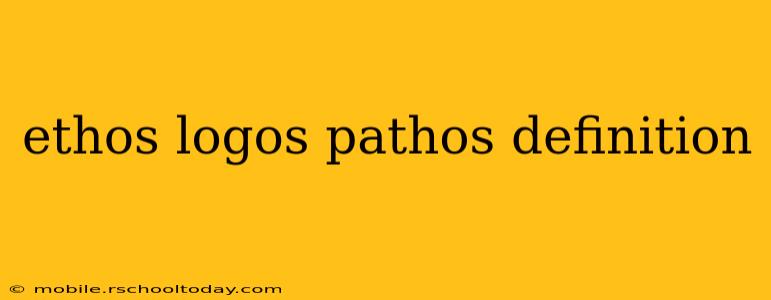The ancient Greek philosopher Aristotle identified three primary modes of persuasion: ethos, logos, and pathos. Understanding and effectively employing these appeals is crucial for anyone seeking to influence an audience, whether in writing, speaking, or any form of communication. This guide will delve into the definitions, applications, and examples of each, providing a comprehensive understanding of this powerful rhetorical framework.
What is Ethos?
Ethos, or the ethical appeal, centers on the credibility and trustworthiness of the speaker or writer. It's about establishing yourself as a knowledgeable, authoritative, and reliable source of information. An audience is more likely to be persuaded by someone they perceive as honest, competent, and well-intentioned.
Building Ethos:
- Demonstrating expertise: Show your audience you know what you're talking about through research, experience, and relevant credentials. Use specific examples and data to back up your claims.
- Establishing common ground: Connect with your audience by sharing values, beliefs, or experiences. This fosters a sense of trust and rapport.
- Maintaining a consistent tone: Project confidence and sincerity in your delivery. Avoid sounding arrogant or condescending.
- Using credible sources: Cite reputable sources to support your arguments and demonstrate thorough research.
- Acknowledging counterarguments: Addressing opposing viewpoints shows fairness and strengthens your credibility.
Example: A doctor recommending a specific medication demonstrates ethos through their professional expertise and medical knowledge.
What is Logos?
Logos, or the logical appeal, relies on reason and evidence to persuade the audience. It involves presenting clear, well-structured arguments supported by facts, statistics, logical reasoning, and examples. A strong logos-driven argument leaves little room for doubt and convinces through the power of logic.
Building Logos:
- Clear and concise arguments: Structure your argument logically, using a clear progression of ideas.
- Supporting evidence: Provide factual data, statistics, research findings, and credible examples to support your claims.
- Deductive and inductive reasoning: Use logical reasoning techniques to connect your evidence to your conclusion.
- Avoiding fallacies: Be mindful of logical fallacies (errors in reasoning) that can weaken your argument.
- Using analogies and metaphors: These can help illustrate complex points and make them more easily understood.
Example: A scientific study presenting data to support the effectiveness of a new drug relies on logos.
What is Pathos?
Pathos, or the emotional appeal, involves connecting with the audience on an emotional level. This doesn't necessarily mean manipulating emotions, but rather using them to enhance the persuasiveness of your message. By evoking emotions such as empathy, joy, sadness, or anger, you can create a stronger connection with your audience and make your message more memorable and impactful.
Building Pathos:
- Using vivid language: Employ evocative language and imagery to paint a picture for your audience and create a more immersive experience.
- Sharing personal stories: Relatable anecdotes can make your message more human and engaging.
- Appealing to values: Connect with your audience's values and beliefs to create a sense of shared purpose.
- Using emotional tone: Adjust your tone to match the emotion you're trying to evoke.
- Employing rhetorical questions: These can prompt reflection and engage the audience on an emotional level.
Example: An advertisement showing a heartwarming story about a family using a specific product to evoke feelings of happiness and family connection employs pathos.
The Synergistic Power of Ethos, Logos, and Pathos
While each appeal can be used independently, their greatest power lies in their combined use. A truly persuasive message typically incorporates all three: a credible speaker (ethos), a logical argument (logos), and an emotional connection (pathos). By mastering these three modes of persuasion, you can craft compelling messages that resonate deeply with your audience and achieve your communication goals. This integrated approach ensures a more impactful and memorable message, ultimately leading to greater persuasion.
